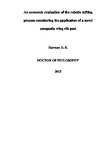An economic evaluation of the robotic tufting process considering the application of a novel composite wing rib post
| dc.contributor.supervisor | Grove, Stephen | |
| dc.contributor.author | Harman, David Edward | |
| dc.contributor.other | Faculty of Science and Engineering | en_US |
| dc.date.accessioned | 2018-02-23T11:35:09Z | |
| dc.date.issued | 2013 | |
| dc.identifier | 306645 | en_US |
| dc.identifier.uri | http://hdl.handle.net/10026.1/10847 | |
| dc.description.abstract |
This thesis aims to establish a greater understanding of the effects of the single-sided robotic tufting process on component manufacturing costs and weight, and subsequently determine whether potential economic benefits can be realised through its implementation. To complete this assessment, the study uses the novel composite rib post application of the Next Generation Composite Wing (NGCW) project as an example case, investigating the component’s manufacturing cost, performance and weight relative to those of a non-tufted rib post with the same initial fabric layup, and a prepreg rib post with the same fibre orientation and fibre volume fraction. Detailed analyses of the tufted composite rib post manufacturing process have established the relationships between its manufacturing activities and the consumed resources, facilitating the creation of a novel cost model incorporating algorithms defining the robotic tufting process, which may be adapted for different geometries and tuft parameters. In addition, novel permeability data for the considered tufted preform have been obtained experimentally allowing the simulation of the liquid composite manufacturing process. The insertion of tufting in the studied arrangement was shown to decrease the in-plane permeability of the preform, reducing the characteristic by a factor of 3.5 in the direction perpendicular to the tuft seams, and 1.8 in the direction parallel. Completing structural analyses and further cost modelling, the study considers the manufacturing costs and weight of each of the studied components when performance is normalised. Implementing weight penalties including lifetime fuel consumption and lifetime revenue, appreciation is given to the potential lifetime costs generated by each of the structural solutions. Comparing the amalgamated costs of each component, relative economy has been evaluated both when considering equipment amortisation and also the use of pre-amortised equipment. Considering lifetime fuel cost/kg as the weight penalty, the novel composite rib post has greater economy within the pure pull-off load case without tufting due to its lower manufacturing costs. However, with the consideration of a more significant weight penalty, such as potential increased lifetime revenue, the use of the novel composite rib post results in superior economy, its lifetime cost/part is estimated to be 14% less than the component without tufting and 61% less than the lifetime cost/part of the prepreg component. Critical evaluations of the project’s methodologies have highlighted the various assumptions made due to the limitations of available information and means to perform certain validations. Under these circumstances the assumptions are believed to be the best representations of what is experienced in reality. As far as possible, errors believed to be the result of assumptions have been accounted for in rigorous error analyses to establish their propagation through the various calculations performed. These analyses have provided confidence in the results of the study, ensuring the significance of the determined economical differences between the investigated components. | en_US |
| dc.description.sponsorship | QinetiQ Group Plc and Great Western Research | en_US |
| dc.language.iso | en | en_US |
| dc.publisher | University of Plymouth | en_US |
| dc.subject | Through-thickness reinforced composite | |
| dc.subject | Economic evaluation | |
| dc.subject | Composite wing rib post | |
| dc.subject | Robotic tufting | en_US |
| dc.subject.classification | PhD | en_US |
| dc.title | An economic evaluation of the robotic tufting process considering the application of a novel composite wing rib post | en_US |
| dc.type | Thesis | |
| plymouth.version | publishable | en_US |
| dc.identifier.doi | http://dx.doi.org/10.24382/3501 | |
| dc.identifier.doi | http://dx.doi.org/10.24382/3501 | |
| dc.rights.embargodate | 26/07/2018 | |
| dc.rights.embargoperiod | Extended | en_US |
Files in this item
This item appears in the following Collection(s)
-
01 Research Theses Main Collection
Research Theses Main


